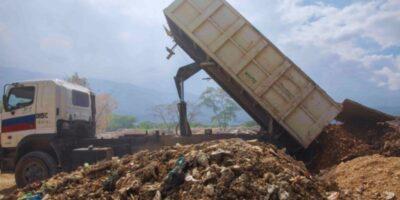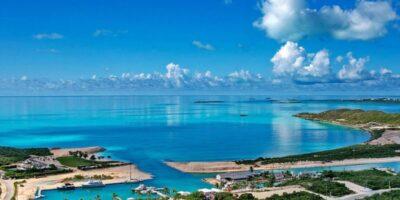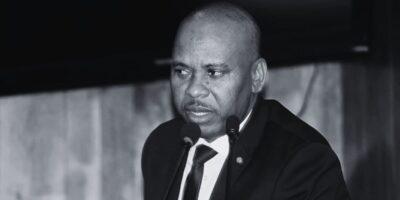A large-scale mining project on the border could lead to an environmental catastrophe for the people of Haiti and the Dominican Republic, report activists to AyiboPost
A Canadian company is reportedly expecting to obtain a permit “very soon” to operate a sizable gold mine near the border of Haiti in the region of Dajabón in the Dominican Republic.
The concession, spanning over 20,000 hectares in Nieta, has been granted to the company Unigold and is bordered to the west by the Libon River, which the neighboring Republic shares with Haiti.
Although the initiative is expected to generate over 60 million US dollars annually, environmental activists in the Dominican Republic are warning of a high risk of environmental disasters such as the contamination of the Artibonite river, Massacre which is already at the center of controversy due to the construction of a canal, as well as the Libon River.
The project could also lead to the mass poisoning of animals, disease, and other negative consequences for the Haitian and Dominican populations on both sides of the border, according to interviews and documents reviewed by AyiboPost.
Although the initiative is supposed to generate more than 60 million US dollars per year, environmental activists in the Dominican Republic are warning of a high risk of environmental disasters…
In addition to contamination concerns, mining operations consume a great deal of water. On average, it takes 500,000 liters of water to extract and wash 1 kilogram of gold.
« Two countries are fighting over a canal that means nothing, but a company is going to take all of the water from the region for its operations, and nobody seems to notice that, » warns Father Osvaldo Concepción in an interview with AyiboPost.
The company’s factories, which are partially funded by a World Bank entity, will leave behind « a pool of waste the effects of which will persist for generations, » fears the priest, who serves as the director of the Montalvo Center, a Jesuit organization that assists Haitian migrants on the other side of the border.
At the end of April 2023, Unigold triumphantly announced the acquisition of an exploration concession granted by the Ministry of Energy and Mines of the Dominican Republic for an additional 10,903 hectares, right next to the existing 9,990 hectares already under the exclusive control of the company in Dajabón. The company expects to receive an operating permit for 75 years.
The announcement is hard to swallow for environmental organizations in the Dominican Republic, but the controversy surrounding the canal is drowning out their warnings in Haiti.
Two countries are fighting over a canal that means nothing, but a company is going to take all of the water from the region for its operations, and no one seems to notice this.
This canal is diverting the attention of both peoples from the exploitation of these mines, » says environmental activist Ruben Vilalona in an interview with AyiboPost. « Several organizations in Dajabón are mobilizing to confront Unigold, » adds the member of the Cross-Border Cultural Dialogue Roundtable.
Read also : Photos | Ouanaminthe : tout en ébullition, tous unis pour finaliser le canal
Unigold promises to produce an environmental and social impact assessment of the project after the approval of the operating concession.
The Haitian Bureau of Mines (BME) is not aware of this initiative, as revealed to AyiboPost by Claude Prépetit, the institution’s general director. Since this is a Dominican project, « this should be handled diplomatically, that’s what I believe, » the engineer continues.
The government did not immediately respond to a request for comments.
Three out of the five largest mining projects in the Dominican Republic are located within border territory. After approval from the Dominican government, Unigold’s operation in Dajabón will become the second-largest mine in the country, following the Pueblo Viejo mine, the largest in all of Latin America.
The company’s factories will leave behind a pool of waste, the effects of which will persist for generations.
The environmental impact of mining at the border threatens resources shared by both countries.
According to a report produced in 2016 by the Dominican Ministry of Economy, Planning, and Development, « the exploitation of mineral resources in the border area between Haiti and the Dominican Republic would significantly increase the demand for water, in a context of high national water stress for both countries, considered among the most affected by the effects of climate change. »
Read also : Haïti sous les griffes des changements climatiques
According to the Dominican government, the significant volume of water required for intensive mining activity over decades « would increase cross-border competition for rivers shared by Haiti and the Dominican Republic, affecting human consumption, traditional agricultural activities, and food security, since water consumption in one country affects water use in the other. »
Haiti is at a greater risk of suffering the negative repercussions of mining operations at its border with the Dominican Republic.
According to the World Bank, Haiti ranks among the countries with the least access to potable water in the world. The country is grappling with watershed degradation, deforestation, and the encroachment of its springs and rivers by waste. Moreover, the concentration of Haitian people along the border remains higher compared to the neighboring Republic.
Haiti is at a much higher risk of suffering the negative repercussions of mining operations at its border with the Dominican Republic.
« Since rivers like Massacre and even the groundwater can be affected, we believe that the Haitian government should request an [explanation], » says Dr. Maismy-Mary Fleurant, an environmental law expert, in an interview with AyiboPost.
According to the specialist, « if this project does not adhere to standards and regulations, it should be halted. What matters, according to Fleurant, is not enriching a company but preserving the lives of people, biodiversity, aquatic and terrestrial ecosystems, and the land that provides food. »
For the Dajabón mine on the border, Unigold is partnering with Barrick Gold Corporation, the second-largest gold mining company in the world. This firm already operates the Pueblo Viejo mine with Newmont Corporation, a leading global gold producer.
In fact, Newmont Corporation holds one of the three major mining exploration permits granted by Haiti near the border in La Miel, La Mine, Treuil, and Memé in the North-East and Central departments. The American company acquired these exploration rights from a Canadian company named Eurasian Minerals in 2012.
If this project does not adhere to standards and regulations, it must be halted. What matters is not enriching a company but preserving the lives of people, biodiversity, aquatic and terrestrial ecosystems, and the land that provides food.
« Mining investments have been suspended in Haiti since 2013, » reports Claude Prépetit, the director of the BME.
However, since 2006, the Bureau of Mines has issued 50 exploration permits, which are now expired, and three operating permits to foreign mining companies and their subsidiaries.
« The conditions are not in place for mining operations in Haiti to benefit the population, » continues Claude Prépetit. « Operating permits need to be renegotiated, and the authority of the state must be restored to control these companies both in terms of taxation and environmental compliance. »
The firm Barrick Gold, which operates with Unigold on the border, has a dark history of human rights and environmental violations, according to interviews with activists in the Dominican Republic and documents reviewed by AyiboPost.
The conditions are not in place for mining operations in Haiti to benefit the population.
From 2013 to 2020, the Pueblo Viejo mine generated $2.6 billion in taxes, which amounts to 2% of the neighboring Republic’s GDP, and created 2,500 jobs.
However, this performance comes with the loss of agricultural productivity near the mine, poisoning of at least a hundred factory workers, the widespread death of livestock, the death of large numbers of fish in the Macagua River, children falling ill, and the closure of schools.
Furthermore, residents of the surrounding areas report skin lesions that can persist for years. In 2014, high levels of cyanide and other heavy metals were found in the blood and urine of inhabitants in four local villages. The tests concluded that the toxins were absorbed through breathing and contaminated water.
Since 2013, communities around the mine have been requesting relocation from the government. Most of their protests have been dispersed with tear gas by the Dominican police. « There is nothing we can do except accept what has happened to us here. No one will listen to us because Barrick [Gold] is more powerful than our president, » said Mitelia Lima, a resident of the affected areas, to Jacobin magazine.
Newmont Corporation and Barrick Gold did not immediately respond to a request for comments from AyiboPost.
***
Haiti and its neighbor, the Dominican Republic, share a complex network of multiple rivers. Water resources do not recognize borders: they originate in both countries, cross the lines drawn by the peoples, meander around mountains and terrain, and follow their natural courses unperturbed.
In 2014, high levels of cyanide and other heavy metals were found in the blood and urine of residents in four local villages. The test concluded that the toxins were absorbed through both breathing and contaminated water.
For example, the Artibonite River originates in the Dominican Republic. It is the largest river on the entire island and flows through the eponymous valley, responsible for 80% of rice cultivation in Haiti.
The Massacre River is also among the shared water resources of the two countries. It originates in the Dominican Republic but is reinforced along its course by several rivers from Haiti.
The Dominican Republic has about ten structures that harness this river for agriculture and consumption.
It was only through the persistence of farmers in the Maribaroux plain under the government of Michel Martelly that the Haitian government began to take a serious interest in the issue.
Read also : Des paysans au Nord-Est affrontent la Banque Mondiale et l’État haïtien
The construction of a canal to irrigate 3,000 hectares of land in the Maribaroux plain began in earnest in 2018 under Jovenel Moïse’s the government. This project, completed to 65%, was halted around the time of the president’s death in July 2021.
In August 2023, farmers from the lower Maribaroux region resumed the work with the assistance of volunteer engineers from the area to address the drought in the region.
Protests from the Dominican Republic were immediate. President Abinader called for a halt to the construction and closed the border with Haiti on September 15, 2023.
« The Dominican Republic is using this canal to further undermine Haiti, » analyzed Smith Augustin, former ambassador of Haiti to the Dominican Republic, in an interview with AyiboPost.
The Dominican Republic has about ten structures harnessing this river for agriculture and consumption.
The neighboring country to Haiti attempted to intimidate the construction workers by force in 2021. At the time, the incident was treated as a diplomatic matter. A meeting was organized, resulting in the release of a joint declaration in May 2021, confirming that the construction did not violate a bilateral agreement signed in 1929, which allows water intake but prohibits deviations that could make the water inaccessible to the other party.
A few days after the release of the declaration, Dominican Foreign Minister Roberto Alvarez renounced its content and demanded the closure of the construction before any further dialogue, according to former ambassador Smith Augustin.
Today, the canal issue has sparked renewed solidarity among Haitians. « We are mobilized to complete the project; we are pooling resources among organizations in the area, » reveals Milostène Castin, head of an organization fighting against the plundering of peasants in the North-East, in an interview with AyiboPost.
Read also : Vaste opération de vol de terrain dans le Nord-Est
Presidential elections are set to take place in 2024 on the other side of the border. In this context, the canal issue is dominating discussions and fueling passions.
Anti-Haitian sentiment appears to be gaining political traction. « It’s local politics, » analyzes Dr. Maismy-Mary Fleurant, a former consultant to the Haitian Embassy in Santo Domingo in 2021, in an interview with AyiboPost. According to the expert, « It’s no longer about legal considerations or good neighborly policies prevailing. »
We are mobilized to complete the project, and we are pooling resources amongst organizations in the area.
Dominican public opinion is, in fact, divided on the issue. « Opposition to the construction of the canal comes from nationalist groups but does not represent all Dominicans, » says activist Ruben Vilalona to AyiboPost.
According to organizations in Dajabón, this issue serves as a smokescreen for the real danger looming over the communities on both sides of the border.
« The real enemy is among us, but we don’t see it, » says Jesuit Father Osvaldo Concepción to AyiboPost.
« As long as people are fighting each other, it weakens the social fabric, » the reverend continues. « The likelihood of coming together to confront Unigold will decrease: only a united civil society on both sides of the border can take a stand in favor of the resources shared by both peoples, » he affirms.
© Cover Image: Pueblo Viejo mine operation in the Dominican Republic – Sercitec ─ Enercore
English translation by Sarah Jean.
Watch this presentation by the sociologist Peterson Derolus, broadcasted on AyiboPost in March 2021, about the risks of artisanal mining for Haiti:
Gardez contact avec AyiboPost via :
▶ Notre canal Telegram : cliquez ici
▶ Notre Communauté WhatsApp : cliquez ici







Comments